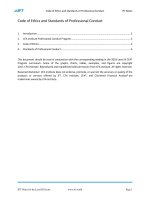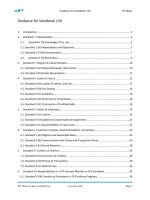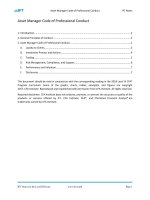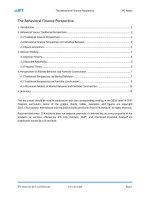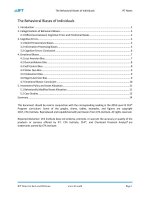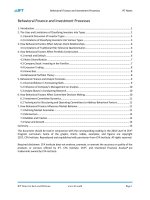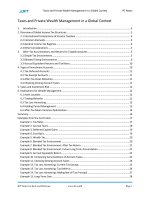CFA 2018 level 3 schweser practice exam CFA 2018 level 3 question bank CFA 2018 CFA 2018 r07 behavioral finance and investment processes IFT notes
Bạn đang xem bản rút gọn của tài liệu. Xem và tải ngay bản đầy đủ của tài liệu tại đây (994.19 KB, 17 trang )
Behavioral Finance and Investment Processes
IFT Notes
Behavioral Finance and Investment Processes
1. Introduction .............................................................................................................................................. 2
2. The Uses and Limitations of Classifying Investors into Types ................................................................... 2
2.1 General Discussion of Investor Types ................................................................................................. 2
2.2 Limitations of Classifying Investors into Various Types ...................................................................... 5
3. How Behavioral Factors Affect Adviser-Client Relationships.................................................................... 6
3.5 Limitations of Traditional Risk Tolerance Questionnaires .................................................................. 6
4. How Behavioral Factors Affect Portfolio Construction ............................................................................. 6
4.1 Inertial and Default ............................................................................................................................. 6
4.2 Naïve Diversification ........................................................................................................................... 7
4.3 Company Stock: Investing in the Familiar ........................................................................................... 7
4.4 Excessive Trading ................................................................................................................................ 8
4.5 Home Bias ........................................................................................................................................... 8
4.6 Behavioral Portfolio Theory ................................................................................................................ 8
5. Behavioral Finance and Analyst Forecasts ................................................................................................ 9
5.1 Overconfidence in Forecasting Skills .................................................................................................. 9
5.2 Influence of Company’s Management on Analysis ........................................................................... 10
5.3 Analyst Biases in Conducting Research ............................................................................................. 10
6. How Behavioral Factors Affect Committee Decision Making ................................................................. 10
6.1 Investment Committee Dynamics..................................................................................................... 11
6.2 Techniques for Structuring and Operating Committees to Address Behavioral Factors .................. 11
7. How Behavioral Finance Influences Market Behavior ............................................................................ 11
7.1 Defining Market Anomalies .............................................................................................................. 11
7.2 Momentum ....................................................................................................................................... 12
7.3 Bubbles and Crashes ......................................................................................................................... 12
7.4 Value and Growth ............................................................................................................................. 13
Summary ..................................................................................................................................................... 13
This document should be read in conjunction with the corresponding reading in the 2018 Level III CFA®
Program curriculum. Some of the graphs, charts, tables, examples, and figures are copyright
2017, CFA Institute. Reproduced and republished with permission from CFA Institute. All rights reserved.
Required disclaimer: CFA Institute does not endorse, promote, or warrant the accuracy or quality of the
products or services offered by IFT. CFA Institute, CFA®, and Chartered Financial Analyst® are
trademarks owned by CFA Institute.
IFT Notes for the Level III Exam
www.ift.world
Page 1
Behavioral Finance and Investment Processes
IFT Notes
1. Introduction
As discussed in The Behavioral Finance Perspective, traditional finance assumes that all investors are
Rational Economic Men who a hold mean-variance optimal portfolio that meets their return objective
and tolerance for risk. The behavioral finance perspective is based on observations that individuals do
not actually behave as they are assumed to by traditional finance. Specifically, individuals are
susceptible to the types of behavioral biases covered in The Behavioral Biases of Individuals, which cause
them to deviate from their mean variance optimal asset allocation. Advisers need to recognize the
behavioral biases that their clients exhibit and may even need to modify portfolios in order to
accommodate them. This reading continues the discussion of behavioral factors with respect to the
adviser-client relationship (sections 2 and 3), and extends the analysis of behavioral finance to portfolio
construction (section 4), investment analysts (section 5), investment committees (section 6) and the
functioning of markets (section 7).
2. The Uses and Limitations of Classifying Investors into Types
This section addresses:
LO.a: Explain the uses and limitations of classifying investors into personality types
The uses of classifying investors into personality types are provided in section 2.1 and the limitations
appear in section 2.2.
2.1 General Discussion of Investor Types
If all investors were Rational Economic Men, as traditional finance assumes, it would be possible to
determine return objectives and risk tolerance based on objective demographic criteria (e.g.; age, life
expectancy, level of wealth) and choose a corresponding mean-variance efficient portfolio. A risk
tolerance questionnaire may also be helpful in this process. However, as seen in the previous readings,
investors demonstrate behavioral biases. Additionally, as discussed in section 3.5, there are limitations
to the use of traditional risk tolerance questionnaires. Therefore, advisors may be able to provide better
service by developing and understanding of their clients’ psychological profile in addition to their
situational profile.
Sections 2.1.1, 2.1.2 and 2.1.3 describe three models that can be used to classify investors based on
their behavioral characteristics. These are meant to assist advisers seeking to develop a fuller
understanding of their clients. For exam purposes, it is important to note that none of this reading’s
Learning Outcomes requires detailed knowledge of the investor types. The models and their associated
investor types are presented in the context of providing advisers with guidance on how to better work
with clients equipped with a deeper understanding of their behavioral influences.
2.1.1 Barnewall Two-Way Model
According to Barnewall, there are two types of investors: active and passive. In general terms, active
investors have generated wealth by risking their own capital (for example, entrepreneurs) and they are
assumed to have a higher risk tolerance than passive investors, who have accumulated wealth by
IFT Notes for the Level III Exam
www.ift.world
Page 2
Behavioral Finance and Investment Processes
IFT Notes
earning a salary (or perhaps from inheritance). In order to determine which category an investor fits
into, an advisor can administer a risk tolerance test such as the one shown in section 2.1.3 of this
reading:
Diagnostic Question
“Have you risked your own capital in the
creation of your wealth?”
“Which is stronger: your tolerance for risk to
build wealth or the desire to preserve wealth?”
“Would you prefer to maintain control over
your investments or prefer to delegate that
responsibility to someone else?”
“Do you have faith in your abilities as an
investor?”
“If you had to pick one of two portfolios, which
would it be?
“Is your wealth goal intended to continue your
current lifestyle, or are you motivated to build
wealth at the expense of your current
lifestyle?”
“In your work and personal life, do you
generally prefer to take initiative by seeking out
what needs to be done and then doing it, or do
you prefer to take direction?”
“Are you capital preservation oriented or are
you willing to put your capital at risk to build
wealth?”
“Do you believe in the concept of borrowing
money to make money/operate a business or
do you prefer to limit the amount of debt that
you owe?”
Active Investor’s Answer
Yes
Passive Investor’s Answer
No
Tolerance for risk
Desire to preserve wealth
Maintain control
Delegate responsibility
Yes
No
80% stocks/20% bonds
40% stocks/60% bonds
Build wealth (at the
expense of current
lifestyle)
Continue current lifestyle
Take initiative
Take direction
Capital at risk
Capital preservation
oriented
Borrow money
Limit debt
This assessment of risk tolerance based on source of wealth will be covered again in section 3.1.1 of
Managing Individual Investor Portfolios.
2.1.2 Ballard, Biehl, and Kaiser Five-Way Model
The Ballad, Biehl, and Kaiser (BBK) model plots investors along two axes, confident-anxious and carefulimpetuous. The five investor types generated by the BBK model are:
Investor type
Adventurer
Celebrity
Individualist
Guardian
Straight Arrow
Personality Axis
Confident
Anxious
Confident
Anxious
Mid-point
IFT Notes for the Level III Exam
Methodology Axis
Impetuous
Impetuous
Careful
Careful
Mid-point
www.ift.world
Adviser relationship notes
Reluctant to take advice
May be willing to take advice
Will listen to advice
May seek advice
Rational
Page 3
Behavioral Finance and Investment Processes
2.1.3
IFT Notes
New Developments in Psychographic Modeling: Behavioral Investor Types
The Pompian model uses a four-step process to classify investors into types:
Step 1: Interview the client and identify active and passive traits and risk tolerance. This is accomplished
using a risk tolerance questionnaire.
Step 2: Plot the investor on the active/passive and risk tolerance scale. Note that, unlike the Barnewell
model, which is binary (active/passive), the Pompian model has two types of passive investors and two
types of active investors.
Step 3: Test for behavioral biases. The diagnostic questions mentioned in The Behavioral Biases of
Individuals can be particularly helpful in this process.
Step 4: Classify investor into a behavioral type. Note that, as mentioned in section 5.1.1 of The
Behavioral Biases of Individuals, investors may demonstrate both cognitive and emotional the biases. In
such cases, it is necessary to determine whether an investor’s biases are primarily cognitive or primarily
emotional.
The four investor types generated by this model are:
Investor type
Passive Preserver
Friendly Follower
Independent Individualist
Active Accumulator
Active/Passive
Passive
Passive
Active
Active
IFT Notes for the Level III Exam
Risk Tolerance
Low
Low-Moderate
Moderate-High
High
www.ift.world
Biases (Primarily)
Emotional
Cognitive
Cognitive
Emotional
Page 4
Behavioral Finance and Investment Processes
IFT Notes
As noted above, the most important use of investor classification models is to provide advisers with
insights that can be used to improve client relationships. For exam purposes, it is less important to know
whether an investor can be classified as a Passive Preserver or Friendly Follower (or a Guardian or an
Adventurer) and more important to be able to identify whether her biases are primarily cognitive or
primarily emotional. (Note that Margaret Neilson is referred to as “a guardian or passive preserver” in
the solution to Practice Problem 10 at the end of this reading). Just as in The Behavioral Biases of
Individuals, Section 5.1.1, the guidelines for advisers are different depending on the nature of a client’s
biases.
The recommendation for advisers who are dealing with clients that demonstrate primarily emotional
biases is to “focus on explaining how the investment program being create affects such issues as
financial security, retirement, or future generations rather than focusing on such quantitative details as
standard deviations and Sharpe ratios.” For example, in Practice Problem 1 at the end of this reading,
Neal Patel’s biases (endowment, loss aversion and status quo) are all emotional and his adviser (Ian
Wang) will therefore want to avoid using technical terms. By contrast, education is the recommended
course of action when dealing with investors who are primarily affected by cognitive biases.
2.2 Limitations of Classifying Investors into Various Types
The curriculum lists five limitations of classifying investors into types based on behavioral models:
1. It is possible, even likely, that individuals will exhibit both cognitive and emotional biases. This
presents a problem for models that classify investors based on the nature of their biases.
2. Individuals may not fit neatly into categories and may exhibit characteristics of more than one
type of investor.
3. Behaviors change over time. Notably, there is a tendency for individuals to become less risk
tolerant and exhibit more emotional biases as they age.
4. Each individual is unique and not all investors that have been placed in the same category will
act identically.
IFT Notes for the Level III Exam
www.ift.world
Page 5
Behavioral Finance and Investment Processes
IFT Notes
5. Individuals can act irrationally and unpredictably. If it isn’t possible to predict market returns,
why should we expect to be able to predict human behavior?
3. How Behavioral Factors Affect Adviser-Client Relationships
This section addresses:
LO.b: Discuss how behavioral factors affect adviser-client interactions
The table below shows four objectives of a successful adviser-client relationship and how behavioral
finance can help achieve each of them. This covers the key material in sections 3.1 through 3.4.
Advisory Relationship Objective
Adviser understands client’s financial goals
Adviser maintains a consistent approach
Adviser invests as client expects
The relationship is mutually-beneficial
How behavioral finance helps achieve this objective
The adviser develops a better understanding of the
client’s motivations in setting financial goals
Clients who feel better understood are more likely to
stick to a recommended investment plan
An adviser who has a deeper understanding of a client’s
behavioral biases is more likely to recommend an
investment plan that meets the client’s expectations
Recognizing and appreciating behavioral biases will
create a stronger advisory relationship
3.5 Limitations of Traditional Risk Tolerance Questionnaires
From a behavioral finance perspective, the limitation of traditional risk tolerance questionnaires is that
they are less useful for developing an understanding of clients affected by emotional biases than they
are for clients whose biases are primarily cognitive. As such, traditional risk tolerance questionnaires
may be more appropriate institutional investors rather than individuals.
4. How Behavioral Factors Affect Portfolio Construction
This section addresses:
LO.c: Discuss how behavioral factors influence portfolio construction
Rather than active like Rational Economic Men, many investors demonstrate behavioral biases that
cause them to hold portfolios that deviate from the mean-variance optimal asset allocation.
4.1 Inertial and Default
As will be discussed in Lifetime Financial Advice, employees (at least in North America) are increasingly
less likely to be able to rely on government assistance and defined-benefit (DB) pensions in order to
meet their own financial needs in retirement. Many employers provide defined-contribution (DC)
pension plans, which offer a range of funds in which employees can invest. If the employee fails to give
instructions, the employer’s contributions are invested in the default option, which is often a low-risk
IFT Notes for the Level III Exam
www.ift.world
Page 6
Behavioral Finance and Investment Processes
IFT Notes
money market fund. Academic studies have shown that employees have a tendency to keep to the
default option, despite the fact that a 100% allocation to a money market fund is inappropriate for
almost all working-age investors. Additionally, investors often fail to adjust their asset allocation to
reflect changes in their personal circumstances (notably, investors should hold fewer risk assets as they
age). These tendencies are a manifestation of status quo bias, which was covered in section 4.4 of The
Behavioral Biases of Individuals.
4.2 Naïve Diversification
Employers who provide DC pension plans are required to offer a range of funds in which employees can
invest. If an employer offers, for example, 4 funds and an employee allocates 25% of his contributions to
each, that employee is demonstrating naïve diversification (also known as “1/n diversification”). Another
example of this behavior would be a fixed-income fund manager who allocates equal amounts of money
to the sovereign debt of each European Union member, regardless of the different risk profiles of these
securities.
4.3 Company Stock: Investing in the Familiar
As will be discussed in Concentrated Single-Asset Positions, a highly-concentrated position in a single
stock exposes an investor to considerable non-systematic risk. Further, as will be discussed in Lifetime
Financial Advice, employees who hold their employer’s stock are exposing themselves to the risk of
losing their job at the same time that the value of their employer’s stock collapses. Therefore, a
concentrated position in one’s own-company stock is inconsistent with a mean-variance optimal
portfolio.
It is important to note that employees who receive financial incentive to invest in their employer’s stock
have rational reasons to do so. However, there is considerable evidence to suggest that investors will
hold own-company stock even in the absence of such incentives. Behavioral finance offers the following
explanations for this irrational behavior:
Familiarity and overconfidence: Employees overestimate the return potential of their employer’s
stock and underestimate its risk. This is consistent with overconfidence bias, which was covered
in section 4.2 of The Behavioral Biases of Individuals.
Naïve extrapolation of past returns: Employees of companies that have performed well over the
previous 10 years allocate 40% of their investment contributions to their own-company stock
(compared to 10% of contributions for employees of poorly-performing companies). This is a
manifestation of representativeness bias, which was covered in section 3.1.3 of The Behavioral
Biases of Individuals.
Status quo effect of matching contributions: When employers purchase own-company stock for
their employees as a default contribution to a DC pension plan, employees may make owncompany stock the default allocation for their own contributions.
Framing effect of matching contributions: An employee who sees his employer purchase owncompany stock, he may take this as implicit advice to do the same with his contributions. This is
a manifestation of framing bias, which was covered in section 3.2.3 of The Behavioral Biases of
Individuals.
Loyalty effects: Employees may be motivated by a sense of loyalty to their employer to hold
IFT Notes for the Level III Exam
www.ift.world
Page 7
Behavioral Finance and Investment Processes
IFT Notes
own-company stock in order to protect against a potential takeover.
4.4 Excessive Trading
It is very difficult for any investor to out-perform the market on a consistent basis. Indeed, there is
considerable evidence showing that the vast majority of investors – even professional fund managers –
fail to do so. Even before accounting for transaction costs, it appears that those who trade excessively,
such as online investors, make poor investment decisions. This may be due to a false believe that they
have special insight, which is consistent with the illusion of knowledge aspect of overconfidence bias
that was covered in section 4.2 of The Behavioral Biases of Individuals. Specifically, excessive traders
tend to sell “winning” investments that have appreciated and hold on to “losing” investments that are
trading below their purchase price. This behavior is consistent with the disposition effect, which is
associated with loss aversion bias (see section 4.1 of The Behavioral Biases of Individuals).
4.5 Home Bias
A rational portfolio is not only diversification across asset classes, but also takes advantage of
opportunities to diversify internationally. Investors who fail to do so exhibit home bias. Behavioral
finance has associated home bias with several of the biases covered in The Behavioral Biases of
Individuals (availability, confirmation, illusion of control, endowment, and status quo). However, for
exam purposes home bias is likely to appear as a stand-alone issue. For example, in Practice Problem 3
at the end of this reading, Sarah Johnson (who is American) demonstrates home bias when she reveals
her aversion to investing in non-US equities. By contrast, Christine Blake from Practice Problem 14 is
said to not exhibit home bias because her portfolio is diversified across four countries.
4.6 Behavioral Portfolio Theory
This section covers:
LO.d: Explain how behavioral finance can be applied to the process of portfolio construction
As mentioned in section 4.3.3 of The Behavioral Finance Perspective, behavioral portfolio theory is
offered as observation of how investors actually build portfolios – as opposed to how they are assumed
to do so according to the traditional finance perspective. Specifically, portfolios are constructed in
layers, each of which is associated with one of the investor’s goals. The asset allocation is different for
each layer and reflects the importance of the corresponding goal. For example, the funds allocated to
cover essential goals such as maintaining one’s standard of living are allocated to lower risk investments.
More aspirational goals are funded with risker assets.
An understanding of behavioral portfolio theory (and behavioral bias) can help an adviser improve a
relationships with clients. For example, layered portfolios are a manifestation of mental accounting bias,
which was covered in section 3.2.2 of The Behavioral Biases of Individuals. Because mental accounting is
a cognitive bias, it may be possible to convince clients who have built such portfolios to accept a more
“rational” allocation by educating them about the benefits of proper diversification that accounts for
correlations between assets.
IFT Notes for the Level III Exam
www.ift.world
Page 8
Behavioral Finance and Investment Processes
IFT Notes
5. Behavioral Finance and Analyst Forecasts
This section covers:
LO.e: Discuss how behavioral factors affect analyst forecasts and recommend remedial actions for
analyst biases
All financial market participants are susceptible to behavioral biases and investment analysts are no
exception.
5.1 Overconfidence in Forecasting Skills
Academic studies have shown that analysts often demonstrate overconfidence bias for overestimating
their forecasting abilities. Because of their extensive training and access to information, analysts may
believe that they are better informed than they actually are, which is known as illusion of knowledge
bias. Overconfidence may also stem from self-attribution bias, which is the tendency to take credit for
one’s successes and blame others (or chance) for one’s failures. As noted in section 4.2 of The
Behavioral Biases of Individuals, both illusion of knowledge bias and self-attribution bias can be seen as
sub-sets of overconfidence bias.
Analysts can demonstrate overconfidence bias by claiming to know an industry better than others or by
using definitive terms, such as “will” or “will not”, when making forecasts when it would be more
appropriate to refer to probabilities. Offering a narrow range of outcomes and overly-precise estimates
reveal overconfidence in the form of underestimating risk. This is a particular concern for analysts who
use complex models. However, overconfidence in the accuracy and precision of estimates derived from
a complex model is also associated with illusion of control bias.
Hindsight bias, the belief that events were (and are) predictable, is related to overconfidence bias
because analysts have a tendency to remember their accurate forecasts and forget or ignore their
inaccurate forecasts. However, while this section describes hindsight bias as involving “both cognitive
and emotional bias”, it should always be considered as a cognitive bias for the purpose of determining
whether an investor’s biases are primarily cognitive or emotional.
5.1.1 Remedial Actions for Overconfidence and Related Biases
Recommendations to help analysts overcome common biases include:
Follow a systematic and structured approach to collect data
Use consistent data
Focus on metrics and comparable data (rather than what is descriptive and unverifiable)
Seek out contradictory facts and opinions
Recognize underlying base rates when assigning probabilities
Incorporate evidence sequentially
Evaluate previous forecasts when making new ones
Make clear, unambiguous forecasts
Document the reasons for making a judgment or forecast
IFT Notes for the Level III Exam
www.ift.world
Page 9
Behavioral Finance and Investment Processes
IFT Notes
Ensure prompt, well-structured feedback from colleagues, superiors and systems
Establish an incentive structure that rewards accuracy
5.2 Influence of Company’s Management on Analysis
Analysts who interact with the management of companies that they cover are susceptible to three
biases: framing, anchoring and adjustment, and availability.
Framing bias: Analysts should remain objective and not allow their thinking to be framed by
others. Specifically, company management tends to be overly optimistic, in part because they
are often affected by their own biases such as overconfidence and illusion of control.
Anchoring and adjustment bias: Analysts will also want to avoid becoming anchored to figures
provided by managers.
Availability bias: Analysts may give too much weight to easily-recallable information provided
by company management.
5.2.1 Remedial Actions for Influence of Company’s Management on Analysis
See the recommendations in section 5.1.1.
5.3 Analyst Biases in Conducting Research
The biases that analysts demonstrate when conducting research are similar to those that appear when
making forecasts (see section 5.1), notably overconfidence and illusion of control. A particular concern
during the research process is confirmation bias, which is the tendency to downplay or ignore
information that contradicts one’s existing beliefs.
In conducting research, analysts collect a significant amount of information. This can lead to
representativeness bias, which is the tendency to place too much emphasis on new information (or
small sample sizes) and neglect base rates. Specifically, analysts may determine that a company fits their
classification as a growth stock and naively extrapolate earnings data.
Representativeness bias may also manifest itself in the form of the gamblers’ fallacy, which is an
unjustified belief that a pattern will revert to its long-term mean within a specific period. In reality,
prices, interest rates and other measures of market activity can deviate from their long-term averages
for extended periods. The opposite of the gamblers’ fallacy is the hot hand fallacy, which assumes that
short-term trends will continue.
5.3.1 Remedial Actions for Analyst Biases in Conducting Research
See the recommendations in section 5.1.1.
6. How Behavioral Factors Affect Committee Decision Making
This section addresses:
IFT Notes for the Level III Exam
www.ift.world
Page 10
Behavioral Finance and Investment Processes
IFT Notes
LO.f: Discuss how behavioral factors affect investment committee decision making and recommend
techniques for mitigating their effects
Individuals, even financial professionals, can be affected by behavioral biases and grouping individuals
into a committee will not eliminate the risk of sub-optimal decisions. Indeed, decisions made by
committees may be more influenced by biases than decisions made by individuals. Specifically,
individuals are susceptible to social proof bias, in which committee members refrain from voicing their
own opinions and adopt the group consensus. It is possible to demonstrate social proof bias even when
one is not a member of a committee.
6.1 Investment Committee Dynamics
Individual members of a committee may withhold contrarian or dissenting opinions in order to avoid
being perceived as an obstacle to reaching a consensus. This self-censorship eliminates the primary
benefit of a committee, which is the collective wisdom obtained from a group of diverse individuals.
Additionally, committees often fail to encourage feedback and learn from past mistakes.
6.2 Techniques for Structuring and Operating Committees to Address Behavioral Factors
The recommendations listed in section 5.1.1 are meant to help analysts make unbiased decisions, but
are equally applicable to committees. What differentiates committee decision-making is the role of the
chair. A chair can make a committee less susceptible to social proof bias by seeking out members with a
diverse range of knowledge and experience, encouraging the airing of dissenting opinions, and ensuring
that all committee members are treated with respect.
7. How Behavioral Finance Influences Market Behavior
This section covers:
LO.g: Describe how behavioral biases of investors can lead to market characteristics that may not be
explained by traditional finance
At the micro level, traditional finance assumes that individuals are Rational Economic Men. Behavioral
finance challenges this by noting observed behavioral biases. At the macro level, traditional finance
assumes that markets are perfectly efficient in that they instantly and fully incorporate all information
into asset prices. Behavioral finance challenges these assumptions by observing what individuals actually
do in the real world.
7.1 Defining Market Anomalies
Market anomalies are persistent deviations from the efficient market hypothesis (EMH). However,
identifying the existence of anomalies is challenging for several reasons:
Valuation model: As noted in section 4.1.3 of The Behavioral Finance Perspective, in order to
demonstrate that an asset’s market prices fails to reflect its intrinsic value, it is necessary to
show what the price should be. The apparent value vs. growth anomaly discussed in section
IFT Notes for the Level III Exam
www.ift.world
Page 11
Behavioral Finance and Investment Processes
IFT Notes
4.1.3.1 of The Behavioral Finance Perspective may not persist after risk measures have been
added to the valuation model.
Spurious relationships: An apparent market anomaly may simply be the result of data mining, or
analyzing data until the point that a correlation is discovered – even when this correlation has
no rational relationship with market prices.
Arbitrage: Assuming that a legitimate market anomaly is discovered, its publication should cause
the mispricing will disappear as self-interested investors to act on this information. Interestingly,
the “January effect” mentioned in section 4.1.3.3 of The Behavioral Finance Perspective persists
despite having been well known for decades.
Rational explanations: Some apparent market anomalies may not be due to irrational factors
such as behavioral biases, but rather they can be explained by rational factors such as taxes or
transaction costs.
Despite the challenges, behavioral finance has identified several market anomalies and offered
explanations based in the behavioral biases of individual investors. Three such anomalies are
momentum, bubbles and crashes, and value stocks vs. growth stocks.
7.2 Momentum
Momentum (or trending) occurs when price movements are correlated with recent past prices. Recall
that, according to the weak-form EMH, current market prices reflect all past price and trading volume
data, which means that this information should have no predictive power.
Trending prices are the macro-level effect of individual investors conforming to a market consensus. This
behavior, known as herding, is associated with regret aversion bias (see section 4.6 of The Behavioral
Biases of Individuals). Seeing a trend, investors want to avoid the regret caused by missing out on an
opportunity to join the crowd.
7.3 Bubbles and Crashes
Bubbles and crashes are defined, respectively, as “negative returns because of prices varying
considerably from or reverting to their intrinsic value.” A more objective measure is asset prices beyond
two standard deviations of their long-term average. During such times, “asset prices become decoupled
from economic fundamentals.” Note that this concept is a direct challenge to the traditional finance
view that market prices always reflect an asset’s intrinsic value. Recall from section 4.1 of The Behavioral
Finance Perspective that one the core principles of traditional finance is that “the price is right”.
The most obvious behavioral bias associated with bubbles and crashes are emotional. Specifically,
Overconfidence is, almost by definition, abundant during bubbles (but not necessarily crashes).
As noted in section 4.2 of The Behavioral Biases of Individuals, this bias causes investors to
overestimate expected returns, underestimate risk, trade excessively, and hold undiversified
portfolios. Self-attribution bias and illusion of knowledge, both of which are subsets of
overconfidence bias, are also present.
As with the momentum effect, regret aversion and its associated herding behavior are also
present during bubbles.
IFT Notes for the Level III Exam
www.ift.world
Page 12
Behavioral Finance and Investment Processes
IFT Notes
Loss aversion bias is present to the extent that investors sell “winning” stocks to lock-in profits
during bubbles and refuse to sell “losing” stocks during crashes.
While the biases listed above (overconfidence, regret aversion, and loss aversion) are all emotional,
investors also demonstrate cognitive biases during bubbles and crashes.
Confirmation bias, the tendency for investors to downplay or ignore information that
contradicts their existing beliefs, is particularly noticeable during rapid expansions.
After a bubble popped and a crash has begun, investors may display anchoring and adjustment
bias by irrationally holding on to positions because they are anchored to a peak or target price.
Hindsight bias is present among investors who are convinced that bubbles and crashes are
predictable.
7.4 Value and Growth
As mentioned in section 4.1.3.1 of The Behavioral Finance Perspective, academic studies have identified
an apparent anomaly in the form of excess returns from investing in value stocks rather than growth
stocks. As noted above, these studies may not be adequately accounting for the risk associated with
value stocks.
Assuming that the value vs. growth discrepancy is a legitimate anomaly, behavioral finance offers the
halo effect as an explanation. In the context of finance, investors demonstrate the halo effect by
noticing an investment’s good qualities and forming a positive opinion of all of its qualities. In Practice
Problem 7 at the end of this reading, Ian Wang’s clients all agree that “they would perceive a company
with a good growth record and good previous share price performance as a good investment.” (Note
that this behavior can also be considered herding). The halo effect is similar to both representativeness
bias because it involves the naïve extrapolation of past returns, and overconfidence bias because those
affected by it tend to overestimate an investment’s expected returns and underestimate its risks.
Home bias, which was discussed in section 4.5 of this reading, is mentioned in this section in the context
of emotional attachments to stocks, but it is not necessarily related to the specific issue of value vs.
growth stocks.
Summary
a. explain the uses and limitations of classifying investors into personality types;
Uses of classifying investors into personality types:
Investors can be classified by their psychographic profile i.e. behavior, personality, attitudes and
interests.
According to Barnewall, there are two types of investors: active and passive as follows.
IFT Notes for the Level III Exam
www.ift.world
Page 13
Behavioral Finance and Investment Processes
IFT Notes
The Ballad, Biehl, and Kaiser (BBK) model plots investors along two axes, confident-anxious and
careful-impetuous as follows.
Limitations of Classifying Investors: An individual may:
exhibit both cognitive and emotional biases at the same time.
reflect characteristics of multiple investor types.
exhibit changing behavior over time.
need unique treatment.
act irrationally and in an unpredictable manner.
b. discuss how behavioral factors affect adviser–client interactions;
Understanding client’s behavioral tendencies allows advisors to:
• better formulate financial goals.
• better understand the client before delivering any investment advice.
• formulate an appropriate asset allocation for the client.
• develop a stronger bond by satisfying clients.
IFT Notes for the Level III Exam
www.ift.world
Page 14
Behavioral Finance and Investment Processes
IFT Notes
c. discuss how behavioral factors influence portfolio construction;
Behavioral Factors/Biases
Impact on Portfolio Construction
Status quo bias
Sticking with default portfolio allocation despite changes in risk
tolerance level or other circumstances.
Regret aversion and framing biases
Naïve diversification or 1/n strategy: allocating an equal amount
of money to available investment options regardless of the
different risk profiles of these options.
Investing in the familiar: a classic example is being overweight in
own-company stock.
Overconfidence, representativeness &
availability, status-quo, framing,
endowment biases
Regret aversion, overconfidence, and
disposition effect (loss aversion) biases
Availability, illusion of control,
endowment, familiarity, and status quo
biases
Excessive trading which results in high transaction costs and poor
portfolio performance.
Investors invest a relatively high portion of their funds in domestic
stocks. Home bias.
d. explain how behavioral finance can be applied to the process of portfolio construction;
Rather than recommending a portfolio that maximizes expected return for a given level of risk,
advisors should recommend an asset allocation that best suits the client’s natural psychological &
behavioral preferences (Recall “Behaviorally modified asset allocation”). The decision whether to
moderate or adapt to a client’s behavioral biases during the asset allocation process depends
fundamentally on 2 factors, i) client’s level of wealth and ii) type of behavioral bias the client
exhibits.
IFT Notes for the Level III Exam
www.ift.world
Page 15
Behavioral Finance and Investment Processes
IFT Notes
e. discuss how behavioral factors affect analyst forecasts and recommend remedial actions for analyst
biases;
Behavioral Factors
Overconfidence in
forecasting skills
Biases
Overconfidence (encouraged by complex
models), representativeness, availability,
hindsight
Remedial Actions
Prompt and accurate feedback, structure
that rewards accuracy, learn to use Bayes’
formula
Influence of
company’s
management on
analysis
Framing, anchoring and adjustment
(analysis influenced by initial default
position or anchor), availability (greater
importance to more easily available
information)
Excessive unstructured information
illusion of knowledge overconfidence
Excessive information feeds
representativeness bias (classify new
information based on past experiences)
Confirmation bias
Disciplined and systematic approach
Analyst biases in
conducting research
Focus on objective data, systematic and
structured approach, follow Standard V,
seek contrary facts and opinions
f. discuss how behavioral factors affect investment committee decision making and recommend
techniques for mitigating their effects;
Social proof bias: Individuals biased to follow beliefs of a group.
Implications:
Group members become overconfident among themselves leading to excessive risk exposure.
Group decisions are more vulnerable to confirmation bias.
Group member avoids divergent opinions to avoid unpleasant tensions within a group.
Remedial Actions
Individual views should be collected before the meeting.
Committee composition should have diversity in culture, knowledge, skills, experience and thought
processes.
Chair of the committee should be impartial.
Committee members should respect opinions of each other.
At least one member of a group should play a role of “devil’s advocate”.
g. describe how behavioral biases of investors can lead to market characteristics that may not be
explained by traditional finance;
Observed Market Behavior
Momentum or trending
effect
Bubbles
Crashes
IFT Notes for the Level III Exam
Behavioral Explanation
Herding behaviour
Availability bias: more recent events easily recalled and given relatively high
weight (recency effect)
Hindsight bias regret trend-chasing effect
Overconfidence bias (illusion of knowledge and self attribution) leads to
underestimation of risk and over-trading
Disposition effect in the context of loss aversion bias: tendency to sell
winners quickly and hold on to losers too long
www.ift.world
Page 16
Behavioral Finance and Investment Processes
Value stocks outperform
growth stocks in the longrun
IFT Notes for the Level III Exam
IFT Notes
Halo effect: tendency of people to generalize positive views/beliefs about
one characteristic of a product/person to another characteristic; related to
representativeness bias refers to classifying new information based on past
experiences
www.ift.world
Page 17

